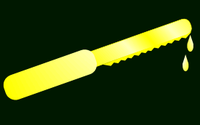Butter knife
“I can't use this!”
– The Human Torch on Butter knives
A butter knife is a hardcore antidepressant made from butter, notable for being thousands of times sharper than a steel knife. Under 30 degrees Fahrenheit, butter knives are among the most versatile in a cook's collection, second only to the CO2 laser. Unfortunately, butter knives tend to lose their edge as soon as the temperature rises above that of a refrigerator. It is recommended to keep the thermostat sub-freezing when using a butter knife. Butter knives have been used as long as people have been harnessing the raw power of winter to form knifelike apparatuses for your breakfastly needs.
How to make a butter knife[edit | edit source]
Making a butter knife is an incredibly long and arduous process, rife with dangers, and thus is best left to the trained expertise of your local butter knife artisans.
History of the butter knife[edit | edit source]
It is difficult to gauge the first usage of butter implements due to their tendency to melt without refrigeration. However, it is known that hardened butter has been in since the Neolithic era due to the presence of cave walls lined with incredibly smooth, deep cuts and dozens of finger bones that litter the floor beneath them. Unfortunately for archaeologists, global warming of the earth over the past few thousand years has caused all ancient butter knives to melt. All that is left are a few knife-shaped grease stains. I wish people would stop warming their bloody globals, it's causing untold damage.
We do know that the Neanderthals used butter spears to kill their prey, and butter arrows and quivers were used in the middle ages. Evidence for this has been found in the European Butter Mountains.
As a weapon[edit | edit source]
Butter knives have a long history as a favorite tool of assassins. Most successful hits have seen the blade left in the wound in hopes of bringing about atherosclerosis in case the attack was not fatal. In the modern age, there has been increasing concern about the possibility of terrorists carrying butter knives, as there is of yet no known method of detection.
